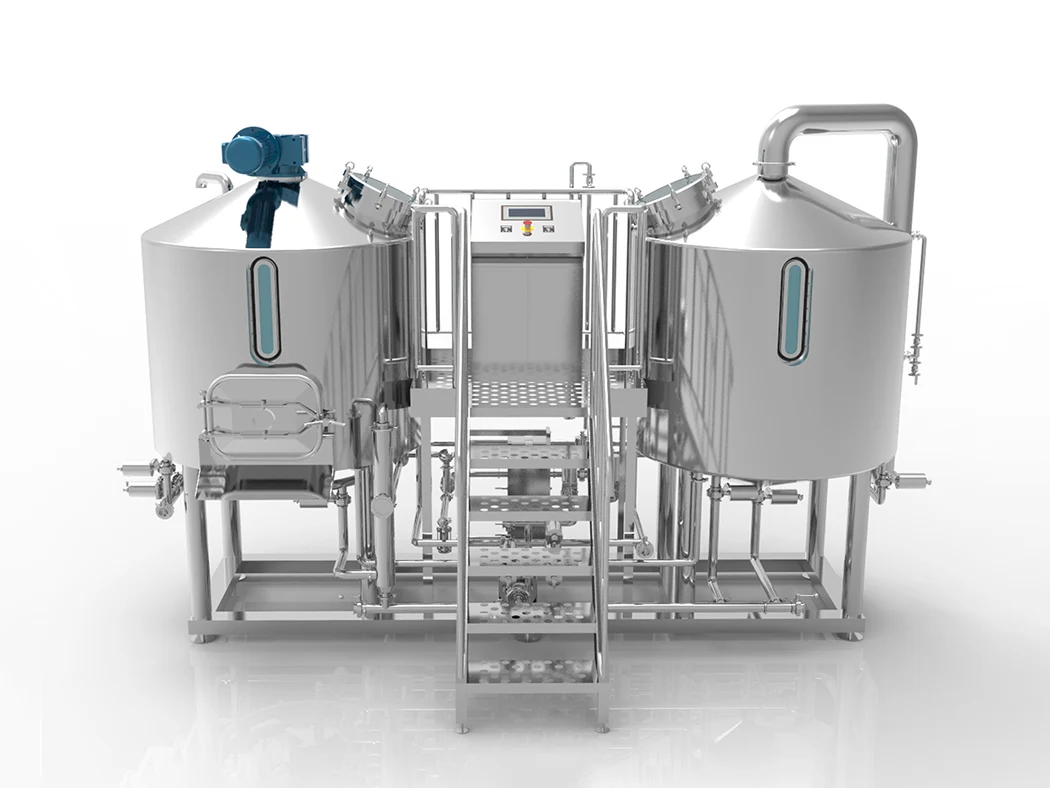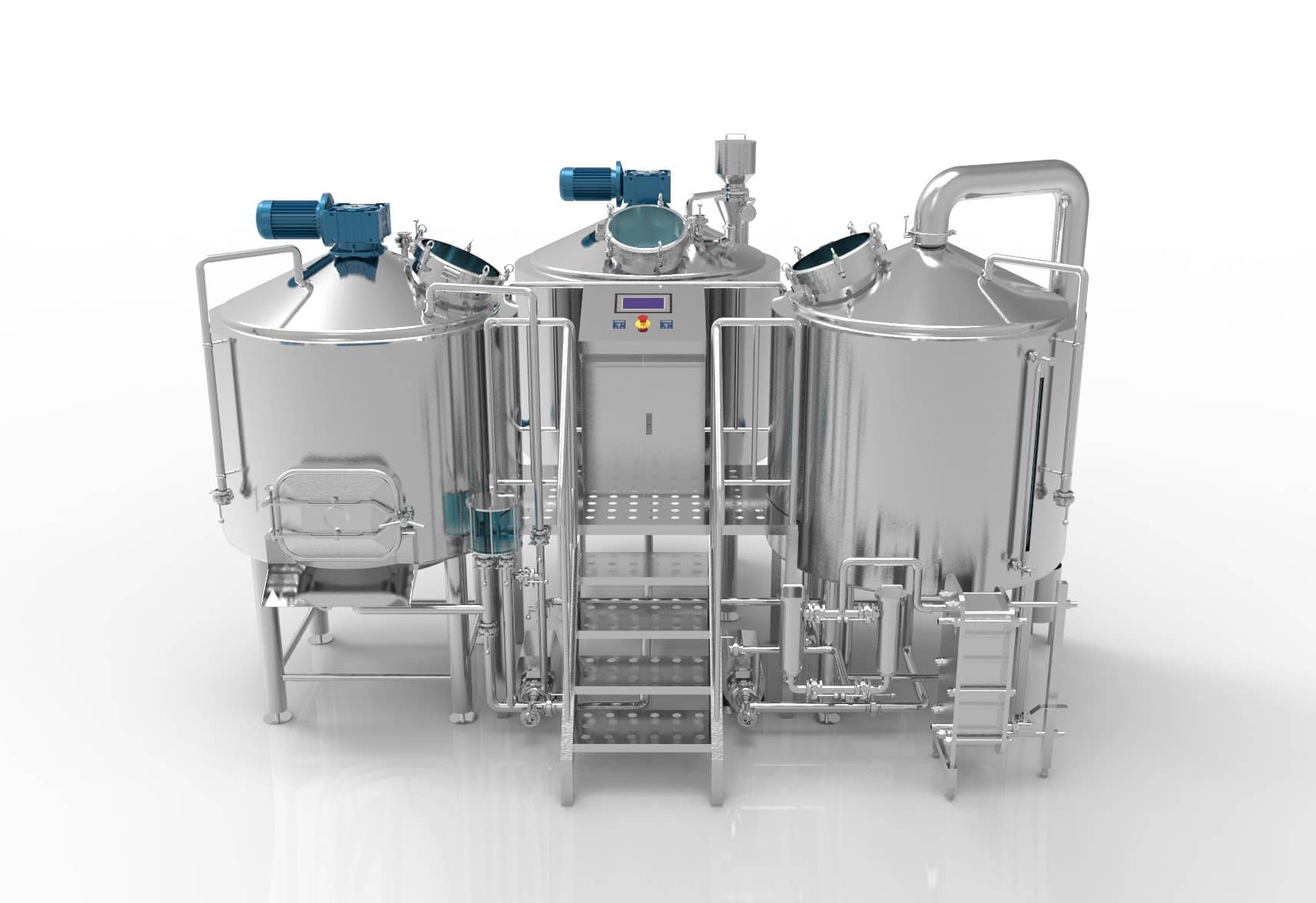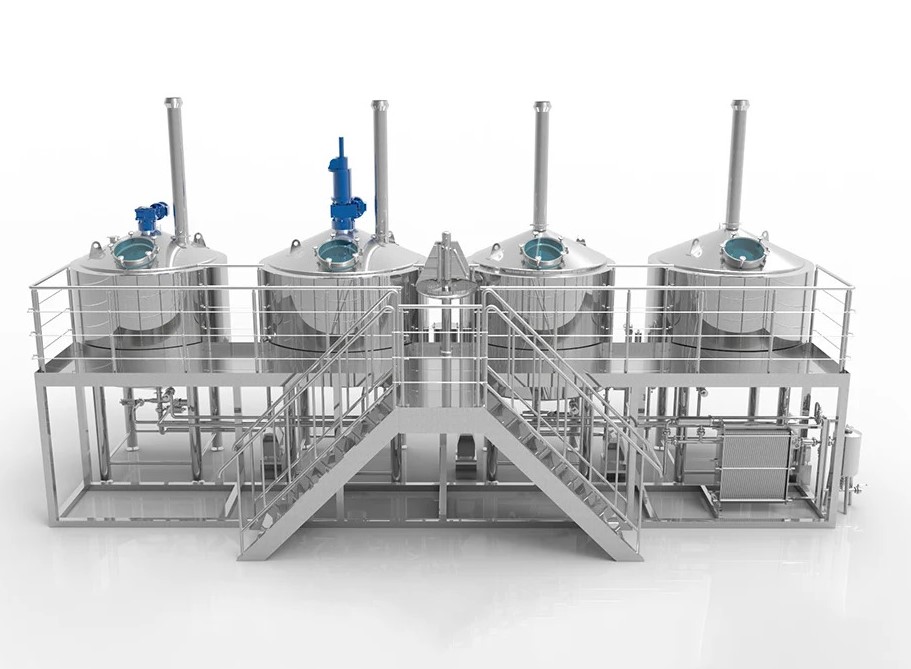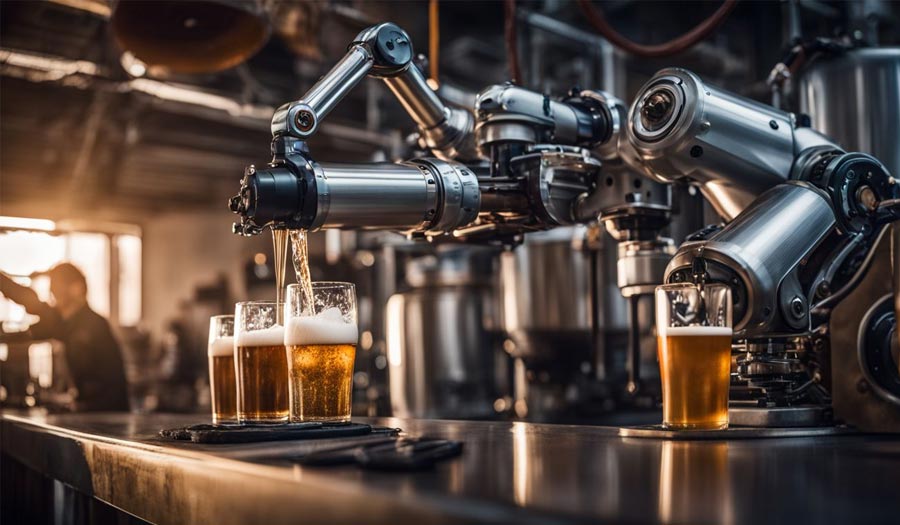Пиво, как один из самых популярных алкогольных напитков, прошло тысячелетнюю эволюцию в процессе приготовления и оборудовании. Начиная с самого раннего ручного брожения, современного промышленного производства и заканчивая современной тенденцией ремесленного пивоварения, технология приготовления пива постоянно обновляется. В будущем, с развитием технологий и изменением потребительского спроса, оборудование для варки пива будет способствовать появлению новых революционных инноваций.
Современное состояние оборудования для варки пива
Традиционное промышленное пивоваренное оборудование
Промышленность оборудование для пивоварения В основном используется на крупных пивоваренных заводах, где основными целями являются высокая эффективность, большие партии и стабильность, а для управления процессом пивоварения используется полностью автоматизированная система управления. Этот тип оборудования включает в себя следующие основные части:
- Система дробления: Тонко регулируя степень измельчения солода, она обеспечивает более равномерное воздействие ферментов в процессе затирания и повышает степень конверсии сахара.
- Система затирания: Обычно используется большой резервуар для сусла из нержавеющей стали, который может точно контролировать температуру и скорость перемешивания для обеспечения стабильности сусла
- Система ферментации: Большие конические емкости для брожения оснащены автоматическими системами контроля температуры для обеспечения эффективной работы процесса дрожжевого брожения и уменьшения образования ненужных примесей.
- Система фильтрации: Используйте высокоточное фильтрационное оборудование, например, центрифуги или мембранную технологию фильтрации, для удаления примесей и улучшения прозрачности и чистоты вкуса пива.
- Система упаковки: Высокоавтоматизированное оборудование для розлива, упаковки и маркировки позволяет эффективно упаковывать продукцию и обеспечивать постоянство ее качества.
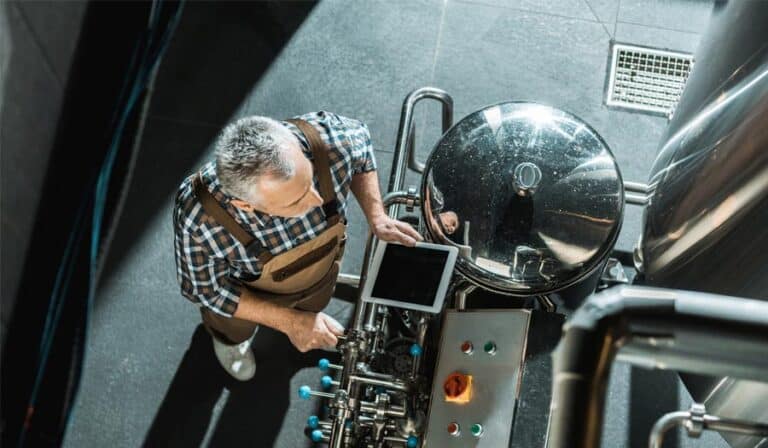
Оборудование для варки крафтового пива
По сравнению с традиционным промышленным оборудованием для пивоварения, оборудование для приготовления крафтового пива уделяет больше внимания гибкости и персонализации, подходит для мелкосерийного производства и высококачественного контроля процесса. Оборудование для крафтового пива обычно имеет следующие характеристики:
- Небольшая затирочная система: Многие ремесленные пивоварни используют небольшую, но полнофункциональную сусловарочную систему, чтобы гибко регулировать соотношение солода, воды и хмеля для создания пива с различными вкусами.
- Независимая емкость для брожения с контролем температуры: Крафтовые пивоварни обычно оснащены несколькими небольшими бродильными емкостями, каждая из которых может независимо регулировать температуру, чтобы удовлетворить потребности в брожении различных типов пива, таких как эль, лагер, кислое пиво и т. д.
- Лабораторное оборудование: Многие ремесленные пивоварни имеют небольшие лаборатории для тестирования ключевых параметров, таких как активность пивных дрожжей, степень затирания солода, значение pH и т. д., чтобы гарантировать качество каждой партии продукции.
- Ручной и полуавтоматический система розлива: Для крафтового пива обычно используется ручное или полуавтоматическое оборудование для розлива, что позволяет более гибко изменять спецификации и дизайн упаковки в соответствии с требованиями рынка к персонализированной упаковке.
Оборудование для домашнего и коммерческого пивоварения
В последние годы, с увеличением числа любителей домашнего пивоварения и ростом спроса на местное крафтовое пиво в небольших барах и ресторанах, на рынке появилось множество оборудования, предназначенного специально для мелкосерийного пивоварения. Такое оборудование обычно обладает следующими характеристиками:
- Интегрированный дизайн: Многие домашние и небольшие коммерческие пивоваренные аппараты имеют интегрированную конструкцию, объединяя в одном устройстве функции затирания, брожения, охлаждения, фильтрации и другие, что сокращает количество этапов работы и повышает удобство.
- Интеллектуальное управление: Некоторые высококлассные домашние пивоваренные аппараты поддерживают интеллектуальное управление с помощью APP. Пользователи могут задавать такие параметры пивоварения, как температура сусла и время брожения, с помощью мобильных телефонов, что позволяет осуществлять удаленный мониторинг и автоматическое приготовление пива.
- Модульное расширение: В некоторых моделях небольшого коммерческого оборудования для пивоварения используется модульная конструкция, позволяющая расширять емкости для затирания, брожения и т. д. в соответствии с потребностями, тем самым постепенно увеличивая производственные мощности.
- Удобная система упаковки: Оборудование для домашнего пивоварения обычно оснащено простой системой розлива или бочками для разливного пива, что удобно для пользователей, чтобы сделать и поделиться своим собственным сваренным пивом.
Технологические тенденции в современном пивоваренном оборудовании
Современное оборудование для пивоварения не только отличается по масштабу, но и постоянно совершенствуется в технологическом плане, чтобы повысить эффективность производства, снизить энергопотребление, оптимизировать вкусовые качества и соответствовать требованиям по защите окружающей среды. К основным технологическим тенденциям относятся:
- Технология автоматического управления: Современное пивоваренное оборудование все чаще использует интеллектуальные системы, такие как PLC (программируемый логический контроллер) и SCADA (сбор и мониторинг данных), чтобы добиться полной автоматизации производства, уменьшить количество человеческих ошибок и повысить стабильность производства.
- Энергосберегающий и экологичный дизайн: Во многих новых пивоваренных установках используются эффективные системы рекуперации тепла, технологии рециркуляции водных ресурсов и т. д. для снижения энергопотребления и загрязнения окружающей среды.
- Точная технология пивоварения: Благодаря мониторингу в режиме реального времени ключевых показателей, таких как температура, уровень pH, ход брожения и т. д., современное пивоваренное оборудование позволяет обеспечить стабильный вкус каждой партии пива и улучшить качество продукции.
- Многофункциональное оборудование: Некоторые высококлассные пивоваренные установки поддерживают варку пива различных стилей, таких как эль, лагер, кислое пиво, бочковое выдержанное пиво и т. д., благодаря чему пивоварни могут быстро корректировать направление производства в соответствии с изменениями рыночного спроса.
Инновационные направления для будущего оборудования для пивоварения
Интеллектуальная автоматизированная технология пивоварения
- Автоматизация производственного процесса: Автоматизированные системы, управляемые искусственным интеллектом, могут точно контролировать процессы затирания, брожения, охлаждения, фильтрации и другие звенья в соответствии с заданными рецептами пивоварения, сократить ручное вмешательство и повысить эффективность производства.
- Дистанционный контроль и облачное управление: Пивовары могут удаленно контролировать и управлять процессом пивоварения с помощью смарт-устройств (например, мобильных телефонов или планшетов), регулировать параметры производства в режиме реального времени, даже если они не находятся на пивоварне, и даже получать предложения по оптимизации, предоставленные искусственным интеллектом.
- Интеллектуальная диагностика неисправностей: Благодаря искусственному интеллекту и анализу больших данных оборудование может автономно обнаруживать потенциальные неисправности и выполнять техническое обслуживание и регулировку до возникновения проблем, сокращая время простоя и повышая эффективность производства.
Экологичная и безопасная для окружающей среды технология пивоварения
- Эффективное управление энергопотреблением: Будущее оборудование будет оснащено более совершенными системами рекуперации тепла для улучшения использования тепловой энергии и снижения расхода топлива. Система охлаждения также будет оптимизировать энергопотребление и снижать расход электроэнергии.
- Рециркуляция водных ресурсов: Процесс пивоварения потребляет много воды. В будущем оборудование будет повторно использовать воду для очистки и охлаждения с помощью передовых технологий фильтрации и рекуперации, чтобы сократить потери воды.
- Утилизация CO₂: Углекислый газ (CO₂), образующийся в процессе брожения, обычно выбрасывается прямо в воздух. В будущем пивоваренное оборудование будет оснащаться системой рекуперации CO₂, чтобы использовать его для газирования или других промышленных целей для сокращения выбросов углекислого газа.
- Биоразложение и повторное использование отходов: В процессе варки пива образуется большое количество побочных продуктов, таких как осадок и остатки солода. В будущем пивоваренное оборудование будет объединено с сельским хозяйством или пищевой промышленностью, чтобы использовать эти отходы в качестве корма для животных, удобрений или пищевых добавок для улучшения использования ресурсов.
Персонализированное и миниатюрное оборудование для пивоварения
- Дом и микро-.коммерческое пивоваренное оборудование: Интеллектуальное оборудование для малых пивоварен станет более популярным, позволяя домашним пользователям и небольшим барам легко варить индивидуальное пиво. Такое оборудование может работать по принципу "одной кнопки", позволяя пользователям начать процесс приготовления пива, просто выбрав рецепт.
- Модульная система пивоварения: В будущем пивоваренное оборудование будет иметь модульную конструкцию, и пивоварни смогут свободно комбинировать различные модули в зависимости от потребностей, такие как мешалки, бродильные танки, фильтрационное оборудование и т. д., чтобы гибко регулировать масштабы производства.
- Платформа персонализированной настройки: Потребители могут даже выбрать свой любимый солод, хмель, дрожжи и другие сырьевые материалы через онлайн-платформу, чтобы создать свое эксклюзивное пиво. Пивоварня производит его на интеллектуальном пивоваренном оборудовании и доставляет непосредственно потребителям.
- Лабораторное оборудование для малых партий: Подходит для пивоваренных заводов, разрабатывающих новые сорта, которые могут быстро протестировать различные рецепты и найти оптимальный рецепт с помощью анализа данных перед началом крупномасштабного производства.
Применение искусственного интеллекта и больших данных в пивоварении
- Оптимизированный искусственным интеллектом рецепт: Анализируя тенденции мирового рынка, вкусовые предпочтения потребителей и данные об истории пивоварения, искусственный интеллект может помочь пивоварам оптимизировать рецептуру пива и создать новые сорта, отвечающие рыночному спросу.
- Интеллектуальное управление процессом брожения: ИИ может отслеживать ключевые данные, такие как температура, содержание сахара, активность дрожжей и т. д. в процессе ферментации в режиме реального времени, и автоматически регулировать условия ферментации для обеспечения наилучшего вкуса.
- Оптимизация цепочки поставок: ИИ может прогнозировать рыночный спрос, оптимизировать закупки сырья и управление запасами, сокращать количество отходов и снижать производственные затраты.
- Персонализированные рекомендации: Основываясь на истории покупок и вкусовых предпочтениях потребителей, искусственный интеллект может рекомендовать наиболее подходящий стиль пива и напрямую предоставлять индивидуальные производственные решения с помощью платформы персонализированной настройки.
Применение новых материалов и новых процессов
- Новые антибактериальные материалы: В будущем в пивоваренном оборудовании могут использоваться более современные сплавы нержавеющей стали или антибактериальные покрытия для снижения микробного загрязнения и улучшения гигиенических стандартов.
- Технология низкотемпературного брожения: В будущем может появиться оборудование для ферментации, способное эффективно работать при более низких температурах, повышать эффективность брожения, снижать энергопотребление и создавать пиво с различными вкусовыми качествами.
- Технология ультразвуковой и нанофильтрации: используется для улучшения прозрачности пива, снижения потерь при фильтрации и удержания большего количества вкусовых веществ.
- Технология автоматической очистки и обслуживания бочек: Для оборудования для подачи разливного пива в барах и ресторанах будущая технология автоматической очистки бочек обеспечит постоянное поддержание оптимальной гигиены пивных бочек.
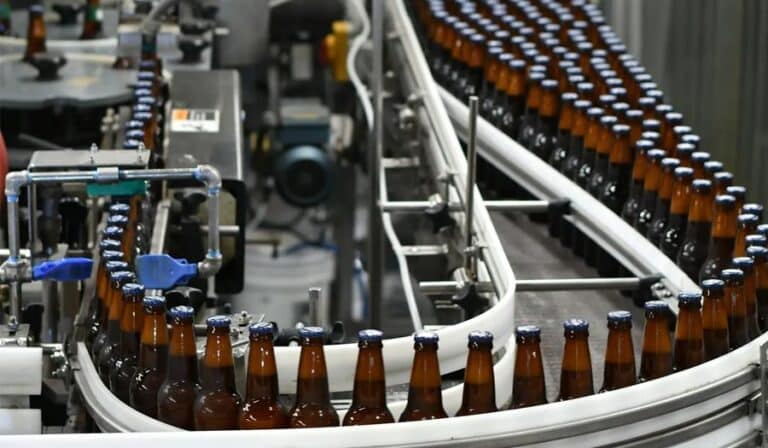
Будущее пива: тенденции и инновации
Устойчивое пивоварение: Экологически чистая революция
Устойчивое развитие - это уже не шумиха, а необходимость. Пивоварни все чаще применяют экологичные методы, чтобы уменьшить свое воздействие на окружающую среду. От использования возобновляемых источников энергии до инновационных систем рециркуляции воды - цель состоит в том, чтобы защитить нашу планету и при этом сварить вкусное пиво. Например, использование солнечной энергии, улавливание CO2 во время брожения и переработка отработанного зерна на корм животным - вот лишь несколько способов, с помощью которых пивоварни становятся "зелеными".
Рост популярности безалкогольного пива
Безалкогольное пиво больше не является скучной альтернативой прошлого. Достижения в технологии пивоварения позволили безалкогольному пиву сохранить весь вкус алкогольного пива. Эта тенденция ориентирована на потребителей, заботящихся о здоровье, а также на тех, кто предпочитает наслаждаться вкусом пива без влияния алкоголя. Рынок этих напитков быстро расширяется, показывая, что отличный вкус не обязательно должен сопровождаться высоким содержанием алкоголя.
Технологические инновации: Варим будущее
Технологический прогресс революционизирует процесс пивоварения. Автоматизация и аналитика данных оптимизируют производство, обеспечивая постоянство и качество. Умные пивоварни используют Интернет вещей (IoT) для мониторинга брожения, контроля температуры и управления запасами в режиме реального времени. Эти технологии не только повышают эффективность, но и дают пивоварам больше свободы для экспериментов и инноваций.
Уникальные вкусовые сочетания: Расширяя границы
Крафтовые пивовары известны своей креативностью, а вкусы будущего пива станут еще смелее. От экзотических фруктов и специй до сотрудничества с обжарщиками кофе и шоколатье - возможности безграничны. Эти уникальные сочетания не только привлекают различную аудиторию, но и переосмысливают сущность пива.
Создание сообщества и сотрудничество
Пивное сообщество сейчас сильнее, чем когда-либо: совместные пивоварни и мероприятия, ориентированные на сообщество, становятся все более распространенными. Такие инициативы способствуют формированию чувства сопричастности и общей страсти у любителей пива. Например, в Канаде пивоварни сотрудничают с местными предприятиями и художниками, создавая уникальные лимитированные сорта пива, воспевающие местную культуру и творчество.

